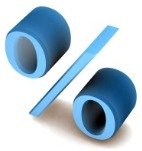Home Page | Blog | Managing | Marketing | Planning | Strategy | Sales | Service | Networking | Voice Marketing Inc.
How to Calculate Profit
for Your Small Business?
Use an Income Statement Example
Calculate profit: money does make the world go round. Small business profits are important for survival. What is profit? Learn to understand what economic and accounting profits are; read and understand financial statements (use an income statement example and balance sheet example). As a small business owner you need to understand the decisions that will help you increase profit and build a successful business.
Search This Site

What is profit?
And how do you calculate profit for your small business?
It is important to understand your business' financial statements and to understand what makes your business profitable - you need that understanding for your operation to survive and grow.
There are good resources available to help you: from accountants, to bookkeepers, training courses, local community centers and colleges, online support and more.
All small business owners need to get good accounting and financial advice.
It is important to talk to a certified and/or professional accountant about your business financials - for day to day and long term advice.
An accountant can help you set up your chart of accounts and bookkeeping files if you're starting up; or an accountant can review your financials and provide advice on how to improve your record keeping.
You can also outsource your bookkeeping - a number of bookkeepers are independents and work for a number of clients.
It is impossible to cover in this website what you would need to know for your business however this site highlights financial and accounting areas to focus on for business growth and business success.
Good finance and accounting processes and procedures are necessary right at the start of your business and need to be maintained on an ongoing basis.
Small Business Profits:
Understanding how business defines and calculates profit is important because profit is necessary for your business to grow and succeed over the long term.
What's the calculation formula?
The simplest formula is:
Total Revenue – Total Expenses = Profit
But it's important to ensure that you have all the revenues totaled as well as include all the expenses: it's easy to overlook some of the costs.
Income Statement Example

Total revenue includes income from operations and sales, investment income and any other revenue sources.
Total expenses includes costs such as your building lease, your equipment, salaries and wages, your materials and supplies, and all other costs related to operating your business (including taxes and interest on debt).
The profit (or loss) is what is left at the end of a defined period. Business owners need to calculate profit margins that they need/want for their business and focus on profit maximization as part of their overall growth strategy.
For example, if your business sold $100,000 worth of business services and your costs for providing those services totaled $96,000, then you would have earned a $4000 profit.
Assuming that your salary was included in the costs, that profit would not be considered large but it would be considered respectable in your first year of business (many businesses are close to break even in years one and two of starting up a business).
(It's useful to look at an income statement example, or sample income statements, to compare the structure of like businesses and see how they calculate profit. It's also useful to look at the income statement example of real competitive businesses - look at the annual reports of public companies if you can - you will find good competitive and comparative information.)
About ten years ago a reasonable profit expectation for companies I worked with was 18%; today companies are excited about an 8% profit – times have changed. Your small business profits goal needs to be 'to earn consistent profits at a planned-for level'.
Make sure you understand the difference between economic and accounting profit (and the difference between other types of profit measures):
- Economic profit: difference between sales revenue and the opportunity cost or value added costs.
- Accounting profit: is the total earnings of the business (sales and other revenues minus costs - including depreciation, interest and taxes).
To reach your profit goals you will need to plan for your success.
Calculate Profit:
Small business profits and sustainability rest on the ability of your business increasing profits to a reasonable, sustainable level. New startup businesses are often at risk of failure in the early years due to a lack of capital and a lack of profit.
When starting up a new business, owners often have to prepare a business plan outline that includes financial, operating and sales projections. Because business owners need startup financing and lenders want to review the business plans before they commit any of their money to the startup.
 Some plans I have reviewed are sadly more wish lists than plans; often the business owner has projected wildly implausible revenues (to calculate profit that will entice investors and/or lenders or maybe justify the reason to start-up the business). Often, after a thorough market review (and over their objections), I start at a fraction of what they believe they can do in sales revenue. Then we look at a best case/worst case look at costs and build a cash flow statement and projection for at least three years, as well as a working capital management plan.
Some plans I have reviewed are sadly more wish lists than plans; often the business owner has projected wildly implausible revenues (to calculate profit that will entice investors and/or lenders or maybe justify the reason to start-up the business). Often, after a thorough market review (and over their objections), I start at a fraction of what they believe they can do in sales revenue. Then we look at a best case/worst case look at costs and build a cash flow statement and projection for at least three years, as well as a working capital management plan.
After the business has been operating for its first year, focus on your gross profit - which is net sales revenue minus cost of goods sold and gross profit margin - which is net sales revenue minus cost of goods sold (COGS) and then divided by net sales revenue. (For example, $100,000 in net sales minus $50,000 COGS divided by $100,000 = 50% gross profit margin.)
In a merchandising operation, the Cost of Goods Sold includes the cost of materials and the cost to produce finished goods during the period; include beginning inventory plus inventory purchases minus ending inventory but not including administration and selling expenses.
By comparing the business' gross profit margin (GPM) to the industry's GPM (which you can often find out from the industry association or from competing publicly owned and publicly reported companies or from lending institutions, which often have data on industry GPM averages), you can assess your business position relative to others.
Target your gross profit margin to be better than 50% (this is not possible in all industries but use this as a stretch objective).
I have worked with young companies with gross profit margins in the 20s,30s and 40s (per cent). They were growing businesses and they struggled with cash flow and funding working capital, product development and market expansion. We re-focused their efforts on increasing sales and decreasing costs to build better gross profit margins.
Small business owners need to focus on not only how to calculate profit but to plan on how to increase small business profits without draining cash or working capital. (Make sure that you also plan ahead for your business exit strategy and that you use the right business valuation methods to assess the value of your business before signing a business sale agreement.)
A strong small business plan, including a business operations plan, human resources plan, marketing plan, sales plan, strategic plan, and, very importantly, a business financial plan will enable small businesses to grow and succeed.
Small business profits will drive your business success and growth. Calculate profit as part of your overall business performance measures. It's pretty simple - without profits, why are you in business?
More-For-Small-Business Newsletter:
For more timely and regular monthly information on managing your
small business,
please subscribe here.
Read More:
Return From Calculate Profit to More For Small Business Home Page.
Subscribe to
More Business Resources E-zine
Meeting Financing Challenges
Getting financing for starting up your new business is a challenge.
But just as challenging is ensuring that you have enough financing to operate your business.
Most businesses do not have a steady flow of cash incoming (or outgoing); it comes in 'fits and starts' no matter how much we try to plan for consistency in cash flow.
You need to ensure that you forecast your cash flow needs realistically and that you are on top of your accounts receivable; do not let your customers use you as their bank (by extending long payment terms), especially during the start up years of your business when every dollar is important to your success.
Make sure that you are clear in setting up new customer accounts: tell your customers what you need and expect in terms of payment (for example, cash on delivery (COD), 15 days from date of invoice, a deposit on order and balance on delivery, etc.).
However, also make sure that your invoice terms are competitive for your industry; check out what your competitors offer and make sure that your terms are competitive. For example, if you want payment in a shorter time frame than your competitor offer an incentive for that earlier payment: perhaps a discount of the next order, or a rebate, or a gift.
This Site
Alternative Financing Strategies Include:
Merchant 'advances': from companies that lend money on credit card cash flow rather than collateral;
Accounts receivables or trade financing: from 'factoring' companies that buy and assume the ownership for the invoice from a customer;
Raise money through preferred shares (non voting) or common shares (voting) in your limited company;
Subordinate financing: typically a higher interest (because it is higher risk) loan based on cash-flow and receivables, rather than on assets.
For each of these alternatives, talk to your accountant and your banker: even if the banker isn't loaning you the money, they can provide valuable input and advice.







